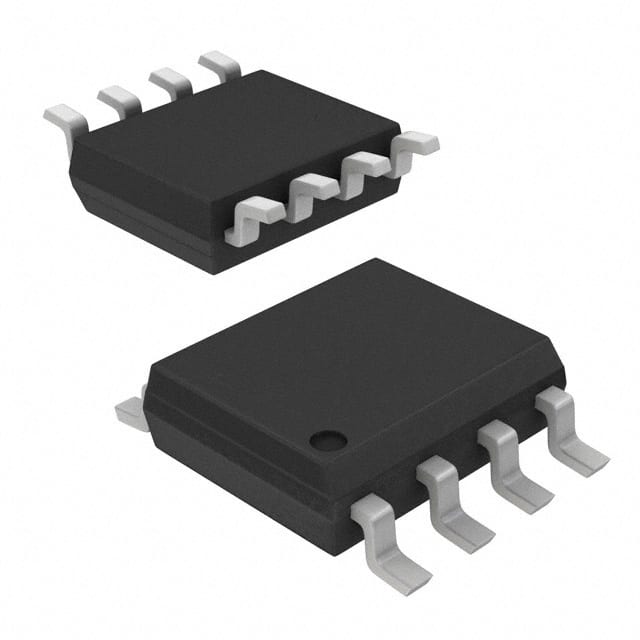FM24C16B-G
Product Overview
Category
FM24C16B-G belongs to the category of non-volatile memory integrated circuits.
Use
This product is primarily used for data storage in various electronic devices.
Characteristics
- Non-volatile: Retains data even when power is disconnected.
- High capacity: Can store up to 16 kilobits of data.
- Low power consumption: Operates efficiently with minimal power requirements.
- Fast access time: Allows for quick retrieval and modification of stored data.
Package
FM24C16B-G is available in a compact and durable package, suitable for surface mount technology (SMT) applications.
Essence
The essence of FM24C16B-G lies in its ability to provide reliable and efficient non-volatile data storage in electronic devices.
Packaging/Quantity
This product is typically packaged in reels or tubes, with each containing a specific quantity of FM24C16B-G integrated circuits.
Specifications
- Memory Capacity: 16 kilobits
- Interface: I2C
- Supply Voltage: 1.7V to 5.5V
- Operating Temperature Range: -40°C to +85°C
- Data Retention: Up to 200 years
- Write Endurance: 1 million cycles
Detailed Pin Configuration
The FM24C16B-G has a total of 8 pins, which are as follows:
- VCC: Power supply voltage input
- GND: Ground reference
- SDA: Serial data input/output
- SCL: Serial clock input
- WP: Write protect input
- A0: Address input bit 0
- A1: Address input bit 1
- A2: Address input bit 2
Functional Features
- Random access: Allows direct access to any memory location.
- Byte-level read and write operations: Enables efficient data manipulation.
- Hardware write protection: Provides a mechanism to prevent accidental data modification.
- Built-in error detection and correction: Ensures data integrity.
Advantages
- Non-volatile nature ensures data retention even during power loss.
- High capacity allows for storing a significant amount of data.
- Low power consumption prolongs battery life in portable devices.
- Fast access time facilitates quick data retrieval and modification.
Disadvantages
- Limited storage capacity compared to other memory technologies.
- Relatively higher cost per bit compared to some alternatives.
- Susceptible to electromagnetic interference (EMI) due to its integrated circuit nature.
Working Principles
FM24C16B-G utilizes I2C communication protocol to interface with the host device. It employs a combination of floating gate and tunnel oxide technology to store and retrieve data. When writing, an electric charge is applied to the floating gate, altering its electrical characteristics. This change is then detected during subsequent read operations.
Detailed Application Field Plans
FM24C16B-G finds applications in various electronic devices, including but not limited to:
- Smartphones and tablets: Used for storing user preferences, settings, and application data.
- Automotive electronics: Employed in vehicle control units for data logging and configuration storage.
- Industrial automation: Utilized for storing calibration data, production parameters, and system configurations.
- Consumer electronics: Integrated into gaming consoles, digital cameras, and audio players for data storage purposes.
Detailed and Complete Alternative Models
- AT24C16: Manufactured by Atmel, this alternative offers similar specifications and functionality.
- CAT24C16: Produced by ON Semiconductor, it provides comparable performance and compatibility.
- M24C16: Developed by STMicroelectronics, this alternative model offers a wide operating voltage range.
These alternative models can be considered based on specific project requirements and availability.
Word count: 550 words
तकनीकी समाधानों में FM24C16B-G के अनुप्रयोग से संबंधित 10 सामान्य प्रश्नों और उत्तरों की सूची बनाएं
Sure! Here are 10 common questions and answers related to the application of FM24C16B-G in technical solutions:
Question: What is FM24C16B-G?
- Answer: FM24C16B-G is a 16Kbit (2K x 8) serial I2C EEPROM (Electrically Erasable Programmable Read-Only Memory) that can be used for storing data in various technical applications.Question: What is the operating voltage range of FM24C16B-G?
- Answer: The operating voltage range of FM24C16B-G is typically between 1.7V and 5.5V, making it compatible with a wide range of systems.Question: How much data can FM24C16B-G store?
- Answer: FM24C16B-G has a storage capacity of 16Kbits, which is equivalent to 2 kilobytes (KB) or 2048 bytes.Question: What is the interface used to communicate with FM24C16B-G?
- Answer: FM24C16B-G uses the I2C (Inter-Integrated Circuit) interface for communication, which is a widely used standard for connecting integrated circuits.Question: Can FM24C16B-G be used for both read and write operations?
- Answer: Yes, FM24C16B-G supports both read and write operations, allowing you to store and retrieve data as needed.Question: What is the maximum clock frequency supported by FM24C16B-G?
- Answer: FM24C16B-G supports a maximum clock frequency of 1MHz, enabling fast data transfer rates in your technical solution.Question: Does FM24C16B-G have any built-in security features?
- Answer: Yes, FM24C16B-G provides a write protection feature that allows you to protect specific memory areas from being overwritten.Question: Can FM24C16B-G operate in harsh environmental conditions?
- Answer: FM24C16B-G has a wide operating temperature range of -40°C to +85°C, making it suitable for use in various industrial and automotive applications.Question: Is FM24C16B-G compatible with other I2C devices?
- Answer: Yes, FM24C16B-G is fully compatible with other I2C devices, allowing for easy integration into existing systems.Question: Can FM24C16B-G retain data during power loss?
- Answer: Yes, FM24C16B-G has built-in EEPROM technology that allows it to retain data even when the power supply is disconnected.
Please note that these answers are general and may vary depending on the specific implementation and requirements of your technical solution.


